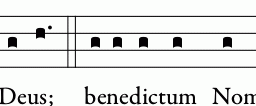Laudes Divinæ - Chant Setting
-
Put this together for a colleague. Unsure of the source. Perhaps she will pitch in with it here :)
-
Is the clef supposed to be F and everything up a line?
-
Very interesting...
-
My guess is IV hypophrygian, transposed, judging by the fiat, amen.
-
Although not the same melody as the one above, the Divine Praises (in Latin) are also found in the 1945 The Saint Andrew Daily Missal, and that melody is another appropriate one. The modern notation is only given for the first couple of verses, and the concluding "Fiat, fiat".Thanked by 1Ben
Welcome to the MusicaSacra Forum!
To participate in the discussions on Catholic church music, sign in or register as a forum member, The forum is a project of the Church Music Association of America.
Categories
- All Discussions21,096
- General Music Discussion8,211
- Job Openings197
- Management of Music Programs850
- Choral Matters532
- Church Documents and Rubrics524
- CMAA Notes301
- Events716
- For Newcomers: Read First26
- Sacred Polyphony546
- Hymnody872
- Gregorian Chant: General2,697
- ↳ Graduale Romanum and Liber Usualis368
- ↳ Graduale Simplex60
- ↳ Semiology63
- Vernacular Plainsong696
- Anglican Use and Anglican Chant68
- Organ, Other Instruments and Repertoire435
- New Composition/Works in Progress1,290
- Recordings230
- Music for Hispanic Ministry159
- Music Education: Children211
- Music Education: General222
- News Items245
- Positions Wanted2
- General Discussion: Catholicism739
- Amusements177
- General Discussion1,033
- Opinions117






